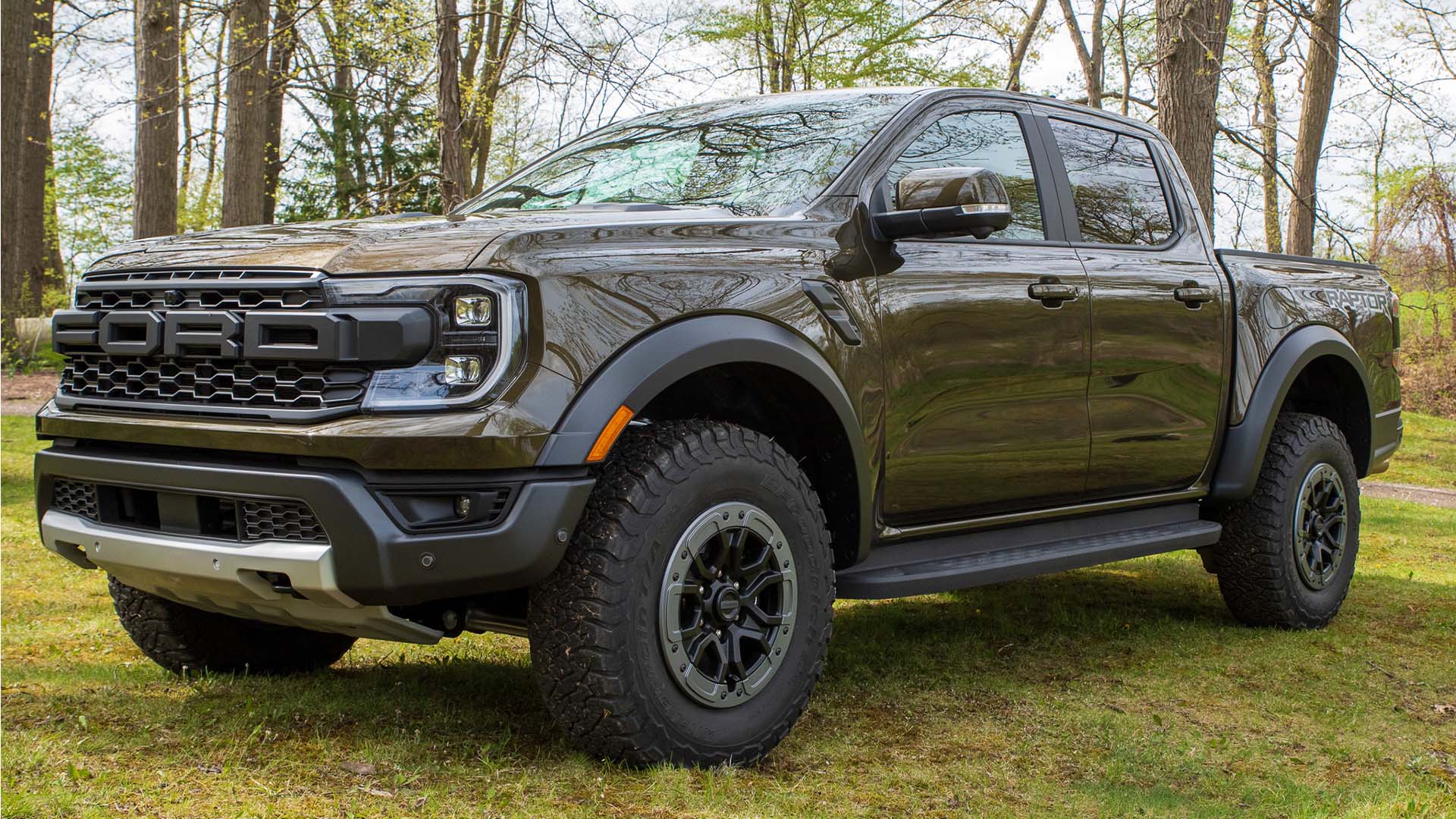

The 2024 Ford Ranger is the latest addition to the Raptor family—in the United States, anyway. It has to meet certain criteria in order to be called a Raptor, and on paper, it seems to tick all those boxes. Its 3.0-liter EcoBoost V6 makes 405 horsepower and 430 pound-feet of torque, meaning it’s plenty quick. It also looks the part with 33-inch BF Goodrich KO3s as well as super-wide fenders. What arguably matters more than any of this, though, is the suspension.
Ford Performance chief engineer Carl Widmann assures me it’s good to go there as well. He and his team spent many a mile testing the Ranger Raptor at locations like Borrego Springs, California, where the terrain is punishing and the speeds are high. That’s the type of environment where this new midsize performance rig shines.
“The 3.0-liter just has so much power, and everything you come into, you come in faster,” Widmann told me at a Ford media event on Monday.

Ford once again tapped on Fox to provide its Live Valve shocks for the Ranger Raptor. These units take a different approach to damping than, say, the Chevy Colorado ZR2’s Multimatic DSSVs. I’ll let the guy who led the truck’s development explain:
“What a Live Valve will do is act like a multiplying effect in what we call damping authority, so you’ll have more ability to catch roll before it happens. That’s what you want so you can carve a line in the desert without the front of the truck falling over on itself. We can basically hold it up with damping control.”

So many of the Ranger Raptor’s suspension upgrades are made in the name of stability. Look at its front end and you’ll see a bespoke setup with wider aluminum upper and lower control arms. It’s different from what you’ll find on a Bronco Raptor as that rig has steel uppers and aluminum lowers. The Ranger Raptor gets away with all aluminum, which is better for weight saving, because it’s already significantly lighter than the Bronco—plus, it only has to deal with 33-inch tires instead of 37s.
“The base Ranger came out with 2 more inches in track width [over the existing model]—we go another 3.5 inches,” Widmann said. “That drives you to a new upper and lower control arm right off the bat. We then set the shock tower as high as we can go, and between those points is where we lay in our shocks. That becomes the critical feature for us to get as much travel as humanly possible because the damper itself is position-sensitive which means it has holes drilled in it vertically, and we call them ride zones. As the piston passes by those zones, they act like bleeds. It’s a tube system that feeds back.”
“Not only does the extra track width give you more stability off-road, but you get travel out of it, too,” Widmann continued. “That’s what drives the design of the entire suspension, so it ends up being its own suspension up front. We do that on all the Raptors.”




Special attention was paid to the pickup’s rear suspension as well. It sports a Watts link setup rather than a more traditional five-link, which is better for—you guessed it—stability. Widmann elaborated on why that was the route they took for the Ranger Raptor by saying, “The Watts link is a suspension that can work on a truck that doesn’t need a leaf spring anymore. In the Watts, what’s different from a five-link is you can get a coilover system in it, which means the shock and spring are now working in the same plane. Your motion ratio or shock effectiveness is easier to tune when it’s a coilover.”
“For this truck, where you want to be able to have a quick reaction on the suspension because you have a coilover front and coilover rear, it’s very much what you would do in a race truck,” Widmann added.

Essentially, it’s more planted and ready to go wherever you point it. That’s key in an application like this where people are paying at least $56,960 for a truck that will wow them off-road. The Ranger Raptor is good at low speed too—it has front and rear lockers—but it’s perfectly happy spending time at full throttle.
Widmann told me this was one area where Ford’s global team really collaborated to deliver the best result. This generation of the Ranger Raptor has been on sale elsewhere in the world, like Australia, for nearly a year. The version we’re getting here is tweaked slightly and has 13 more horsepower, but a lot of what underpins the truck is carried over.
“A Watts link controls the rear axle position better,” Widmann said. “On a five-link, it has a little more compliance but if you look at this thing underneath, it is pretty much zero compliance. It’s got one link on the center instead of two coming back. That’s why you’ll sometimes see a Watts come into a car application and in this package, it works really well. The team had experience with this type of suspension off the [Australian market] Everest [SUV], and it was also in the Gen 1 Ranger Raptor, so a lot of experience means you’ve got a lot of proven durability, which is big for us. For a spirited, nimble kind of driving, a lower compliance system works really well for it.”
It’ll be a while before we’re able to judge for ourselves just how good this truck is from behind the wheel. On the surface, though, it seems like extremely capable competition for the Colorado ZR2. You can see how they stack up here and make the call for yourself, but right now is an exciting time to love off-roading.
Got a tip or question for the author? Contact them directly: caleb@thedrive.com